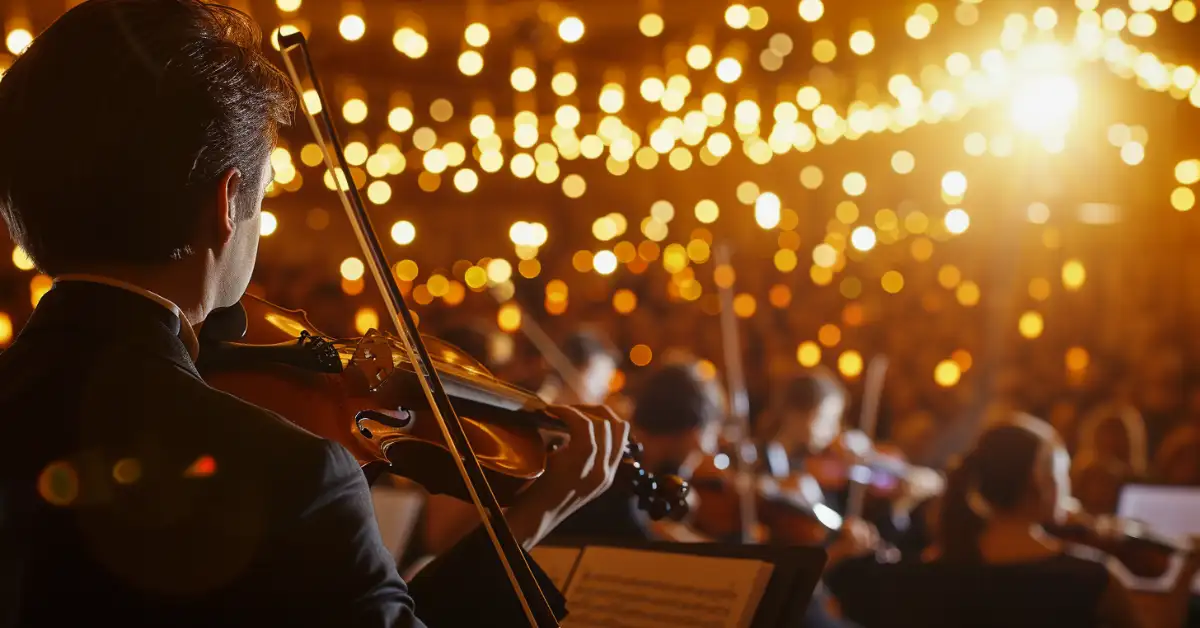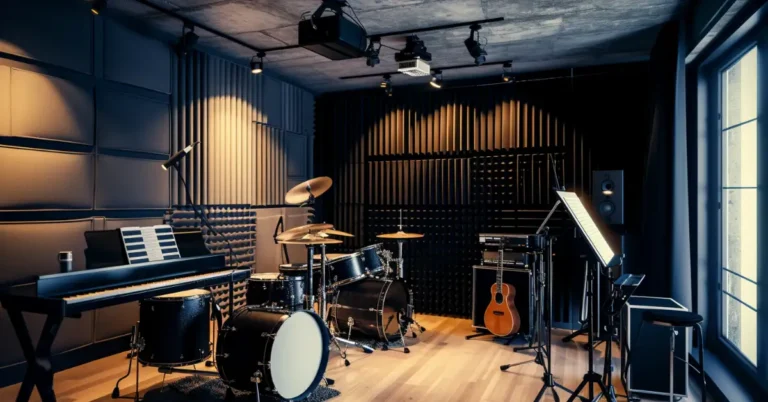Discover the fascinating world of contemporary classical music, where tradition meets innovation. This genre blends classical techniques with 20th and 21st-century styles to create a rich tapestry of sounds. While maintaining the essence of classical music, contemporary classical music breaks free from the past, infusing fresh perspectives and eclectic influences.
What Are The Origins And Evolution Of Contemporary Classical Music?
We often hear the term “contemporary classical music”, but where did it come from, and how has it evolved?
Contemporary classical music, born in the 20th century, breaks from tradition with experimental techniques and has been shaped by pioneers like Arnold Schoenberg and Philip Glass. The genre includes diverse movements such as Minimalism and Neoromanticism and has been influenced by technological advances in electronic and computer music. It enjoys a global presence with a rich variety of styles and influential composers.
Emerging in the 20th century, contemporary classical music sought to break free from the traditional conventions of the past. Classical music, evolving from the Baroque and the Classical era, had been primarily rooted in forms like symphony, opera, and chamber music. However, composers of the modernist era looked to forge new paths and experiment with new techniques like atonality and serialism.
Arnold Schoenberg, a prominent figure in modernism, turned the music world on its head by introducing atonality, which moved away from the established tonal system. His development of the twelve-tone technique, later expanded upon by composers like Alban Berg, Anton Webern, and Pierre Boulez, helped to redefine classical music in the 20th century.
Post-World War II, European and American traditions diverged somewhat, leading to the rise of influential composers such as Pierre Boulez, Luigi Nono, and Karlheinz Stockhausen. These pioneers pushed the boundaries of contemporary classical music, incorporating avant-garde concepts, electronic music, and minimalist styles.
In more recent years, contemporary classical music has continued to evolve, with compositions growing even more diverse in terms of style and technique. Styles like spectral music and post-minimalism have emerged, broadening the scope and range of what can be considered part of this musical landscape.
As we’ve seen, contemporary classical music has its roots in earlier classical forms, but it has constantly evolved to challenge the status quo. Throughout the years, innovative composers defied conventional norms, leaving behind a rich and varied legacy that continually inspires musicians today.
Movements

We all know how diverse and intriguing contemporary classical music can be. This captivating genre has seen the rise of numerous distinctive movements that contribute to its evolution and richness. Some of the notable trends within this realm include Neoromanticism, High Modernism, New Complexity, and Historicism.
Neoromanticism emerged as a direct response to Modernism, with composers seeking to reconnect with the expressive and emotional aspects of Romantic-era music. This movement brought about a resurgence of lush harmonies and sweeping melodies, offering a familiar warmth to contemporary audiences.
High Modernism, on the other hand, represents the pinnacle of experimentation in musical language and structure. This movement is characterized by its embrace of dissonance, atonality, and serialism, pushing the boundaries of traditional musical forms. Pioneers like Igor Stravinsky and Arnold Schoenberg helped shape this revolutionary wave.
New Complexity is a movement known for its intricate and dense compositions, often requiring astounding virtuosity from performers. The music within this movement cleverly exploits complexities in rhythm, pitch, and notation, and can be considered challenging yet highly rewarding for both performers and listeners.
Finally, Historicism refers to the conscious revival of past musical styles within contemporary classical music. Composers often pay homage to earlier eras, such as the Baroque or Renaissance periods, by making use of period-specific musical techniques and instrumentation while incorporating modern elements.
Key Influencers

As fans of contemporary classical music, we’re thrilled to introduce you to the key influencers in this fascinating genre. These composers have left their mark on the musical landscape, shaping the sound of classical music as we know it today.
Notable Works and Compositions
Some of the must-know works in contemporary classical music come from innovators such as Steve Reich, Terry Riley, Philip Glass, and John Adams. These American composers have made significant contributions to the minimalism movement, a transformative era in Western classical music.
Reich’s groundbreaking piece, Music for 18 Musicians, showcases his talent for rhythmic complexity and tonal exploration. Riley’s milestone composition, In C, is considered a pioneering work in minimalism, while Glass’s mesmerizing operas, such as Einstein on the Beach, have captivated audiences around the globe.
European composers also play a substantial role in shaping contemporary classical music. Some notable figures include:
- Pierre Boulez: A dynamic French conductor and composer, Boulez pushed boundaries with works like Répons
- Karlheinz Stockhausen: A German visionary known for his experimentation with electronic music, Stockhausen’s avant-garde masterpiece Gesang der Jünglinge left a lasting impact
- Olivier Messiaen: This innovative French composer blended a myriad of inspirations, from Indian rhythms to bird song, in works such as Turangalîla-Symphonie
Other important names in contemporary classical music include Ligeti, Schnittke, Takemitsu, and Lutosławski—each bringing their unique voice to the mix.
Characteristics of Contemporary Classical Music

Contemporary classical music is an exciting and diverse genre that has evolved significantly over the past century. Its ever-changing landscape offers listeners a rich variety of styles, making it one of the most intriguing areas of the musical world today.
Minimalism is a prominent style within contemporary classical music and emphasizes simplicity and repetition as a means to create a sense of calm and focus. Minimalist composers, such as Steve Reich and Philip Glass, use this technique to create mesmerizing, hypnotic works that captivate audiences.
Another notable subgenre is experimental music, which often pushes the boundaries of traditional classical music by incorporating unconventional instruments, sounds, and structures. This avant-garde approach encourages exploration and innovation, creating unique musical experiences that challenge preconceived notions of what classical music should be.
Spectral music is a style that gives priority to the harmonic properties of sound and the manipulation of timbre. It often eschews traditional tonality in favor of exploring the nuances of sound and texture. This highly detailed approach to composition can produce haunting and evocative musical landscapes.
Post-minimalism is a reaction to the strictures of minimalism, blending minimalist elements with elements from other styles like neoromanticism and postmodernism. This synthesis results in a more dynamic and expressive musical language that retains some minimalist qualities while expanding the composer’s palette.
Electronics and computer music are also important aspects of contemporary classical music, allowing composers to manipulate sound in ways never before possible. Through sampling, digital synthesis, and other cutting-edge techniques, these genres open up a world of sonic possibilities that continue to push the boundaries of music.
Technological Advances Impacting Contemporary Classical Music
As lovers of contemporary classical music, we can’t help but notice the significant impact technology has made on the genre. The fusion of electronic music, computer music, and electro-acoustic techniques brings a new dimension to classical compositions, reshaping the way we listen and create.
One of the transformative elements in contemporary classical music is the integration of electronic music. Composers now incorporate synthesizers, samplers, and other digital instruments, pushing the boundaries of their sonic palettes. These electronic elements give a fresh and modern feel to classical compositions, creating exciting new soundscapes for both performers and audiences alike.
In addition to electronic instruments, computer music has revolutionized the way contemporary classical music is composed and produced. Software like digital audio workstations (DAWs) and notation programs offer unparalleled flexibility and control, facilitating complex arrangements and intricate sound manipulation. This allows composers to intricately craft their scores while experimenting with a vast array of timbres, textures, and sound layers.
Finally, the development of electro-acoustic techniques has opened up a world of possibilities for contemporary classical music. By combining traditional instruments with electronic elements, composers create rich, multi-dimensional soundscapes that can transport audiences to new realms of the imagination. Examples of these techniques include the use of computers to process live sound, the integration of pre-recorded soundscapes, and the manipulation of natural acoustics through digital tools.
Contemporary Classical Music Around the World

As lovers of contemporary classical music, we’ve been thrilled to see how it has blossomed around the world. Let’s dive into the global landscape of this dynamic genre, exploring its various styles and influential composers.
In the United States, American minimalist pioneers like Steve Reich and Philip Glass redefined the boundaries of contemporary classical music with their mesmerizing, repetitive patterns. Their groundbreaking work continues to captivate listeners and inspire new generations of composers.
Across the Atlantic in France, a vibrant scene has emerged. One notable Frenchman is composer Gérard Grisey, who played a key role in the development of spectral music – a style focused on exploring the complexities of sound and the harmonic spectrum within compositions.
Ireland also boasts a rich tradition of contemporary classical music. Irish composer Donnacha Dennehy masterfully combines traditional Irish melodies with fresh, modern techniques, creating an innovative sound that resonates with audiences in his home country and beyond.
On the West Coast of the United States, the city of Los Angeles has become a hotspot for contemporary classical music. The Los Angeles Philharmonic, under the leadership of Gustavo Dudamel, regularly champions new works, attracting top composers and fostering a thriving community of artists.
Of course, we can’t overlook the cutting-edge sounds and daring compositions of avant-garde tearaways like John Cage and Karlheinz Stockhausen. Their unorthodox approaches have expanded the boundaries of contemporary classical music, transforming how we think about and experience sound.
FAQ
What is the best contemporary classical music?
The best contemporary classical music is subjective and varies based on personal taste. However, some popular contemporary classical composers and works include Max Richter’s “The Blue Notebooks” and John Luther Adams’ “Sila: The Breath of the World.”
What are the characteristics of contemporary classical music?
Contemporary classical music encompasses a wide variety of techniques, philosophies, and influences, making it difficult to define. It is composed close to the present day and tends to use instruments associated with a symphony orchestra rather than electric guitars, drums, and synthesizers.
What is the difference between classical music and contemporary music?
Classical music is more complex and structured, while contemporary music is generally more popular and uses simpler musical language
What are the examples of contemporary music?
Contemporary music refers to any music being written today or recently, regardless of style or genre. Examples of contemporary music include Beyonce’s “Crazy in Love,” Mark Ronson’s “Uptown Funk,” and Victor Wooten’s “La Lección Tres.”
If you liked this blog post about the topic: “Contemporary Classical Music”, don’t forget to leave us a comment down below to tell us about your experience with it.
If you want to keep reading more from us, have a look at these articles.





